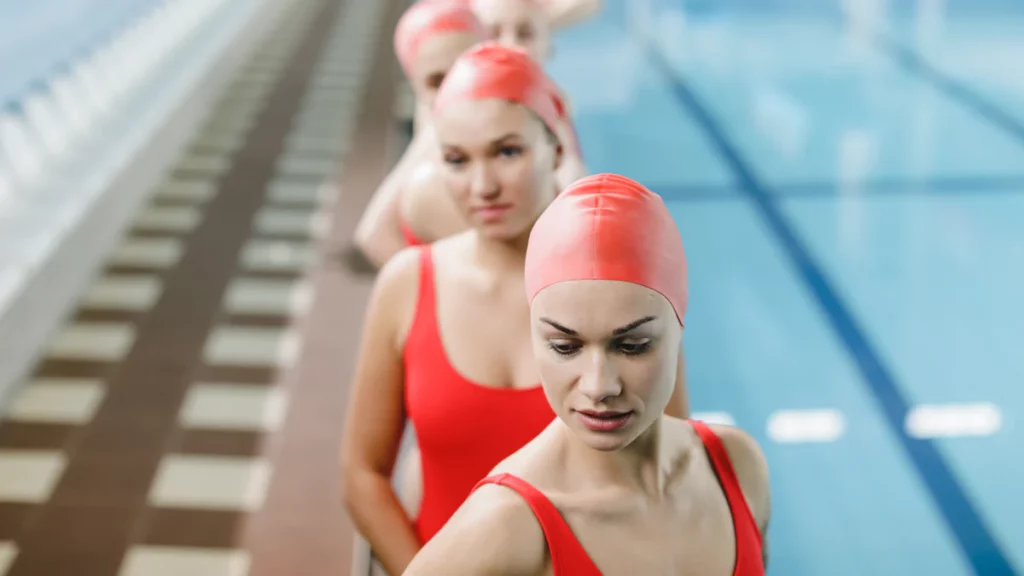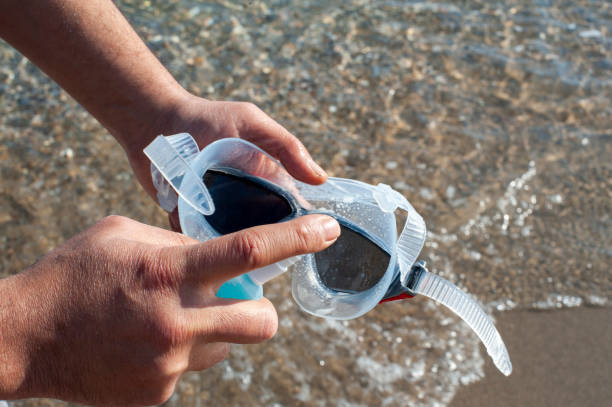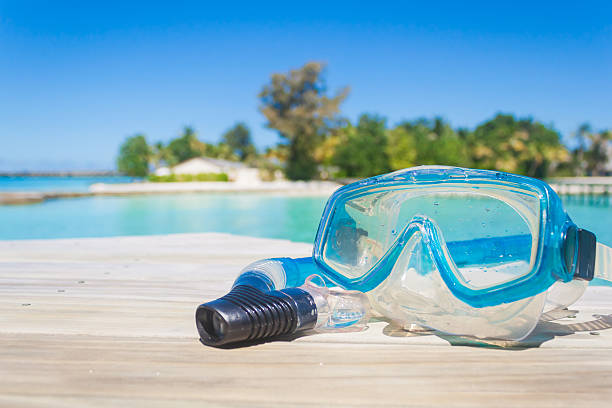スタイリッシュさと機能性が最高に楽しく融合した、スイムキャップの世界へようこそ!様々なタイプのスイムキャップをじっくりとご覧いただき、無限の可能性の海へ飛び込んでみませんか?シリコン製からラテックス製まで、それぞれのキャップに物語があります。様々なタイプのスイムキャップの秘密を解き明かし、あなたの水遊びの魂に一番合うキャップを見つけましょう。

スイミングキャップの5つの種類
さまざまなタイプの 水泳帽スイムキャップの性能を決定づける重要な要素は素材です。スイムキャップの素材の世界を覗き込み、それぞれの特徴を探ってみましょう。
シリコーン
シリコンキャップは耐久性と流体力学に基づいたデザインで知られ、プロのスイマーに愛用されています。頭にぴったりフィットし、保護性能と水中でのパフォーマンス向上の両方を実現します。鮮やかなカラーは、特に外洋での視認性を高めるだけでなく、目立つ効果も発揮します。さらに、シリコンキャップは抵抗を軽減するため、水中をスムーズに滑ることができます。
利点
- 耐久性: シリコン キャップは耐久性に優れていることで知られており、形状や色を失うことなく頻繁に使用しても耐えられる、長持ちする水泳のお供となります。
- 流体力学設計: シリコン キャップの流体力学設計により水の抵抗が軽減され、水中を楽に滑ることができ、全体的なパフォーマンスが向上します。
- 鮮やかな色: シリコン キャップは、鮮やかな色を幅広く取り揃えており、ファッション性を高めるだけでなく、水中での視認性も向上し、オープンウォーター スイミング中に他の人があなたを見つけやすくなります。
理想的な使用例
- 競泳: 水中でのスピードと効率を最大限に高めたい競泳選手にとって、流体力学的特性を備えたシリコン キャップは理想的な選択肢です。
- トレーニング セッション: ストロークの練習でも、持久力のトレーニングでも、シリコン キャップはプールでの長時間のトレーニング セッションに必要な耐久性と快適性を提供します。
ラテックス
ラテックスキャップはシリコンキャップの手頃な価格の代替品です。シリコンキャップと同様にしっかりとフィットしますが、薄く、破れやすいという欠点があります。それでも、カスタマイズ性の高さから水泳チームに人気です。ロゴやデザインで個性的なキャップに仕上げることで、水泳用品にスタイリッシュなアクセントを加えることができます。
利点
- 手頃な価格: ラテックス キャップの主な利点の 1 つは、手頃な価格であることです。そのため、予算を抑えながらぴったりとしたフィット感を求める水泳選手にとって、ラテックス キャップは予算に優しい選択肢となります。
- カスタマイズ性: 他のタイプのスイムキャップとは異なり、ラテックス キャップはロゴやデザインで簡単にカスタマイズできるため、スイマーは自分のギアに個性を加えることができます。
- ぴったりフィット: 薄い素材を使用しているため、ラテックス キャップはぴったりフィットし、水中での抵抗を減らし、ストロークごとにより効率的に移動できるようにします。
理想的な使用例
- チームイベント: 多くの水泳チームは、チームメンバーに一致する装備を装備するためのコスト効率の高いソリューションを提供するため、ラテックス キャップを選択します。
- レクリエーション水泳: ビーチやプールでのカジュアルな水泳に適したシンプルかつ効果的なスイムキャップをお探しの場合は、快適なフィット感と手頃な価格のラテックスキャップが最適です。
ライクラ/スパンデックス
ライクラ/スパンデックス製のキャップは快適なフィット感を提供しますが、シリコンやラテックス製のキャップに比べると耐水性に劣ります。水泳中にキャップがずり落ちないように、あご紐付きのライクラキャップを選ぶことをおすすめします。これらのキャップは、パフォーマンスよりも快適性を重視するカジュアルなスイマーに最適です。
利点
- 快適なフィット感: ライクラ/スパンデックスの伸縮性により、これらのキャップは、締め付け感や窮屈感を感じることなく、長時間着用しても非常に快適です。
- 通気性のある素材: シリコンやラテックスとは異なり、ライクラ/スパンデックスは水泳中に頭皮が呼吸できるようにし、水中で長時間過ごす際の過熱や不快感を防ぎます。
- チンストラップ オプション: 一部のライクラ/スパンデックス キャップにはチンストラップが付いており、水中で激しく動いてもキャップがしっかりと固定されます。
理想的な使用例
- ゆったりとした水泳: ゆったりとした水泳や水中フィットネス クラスを楽しむ人にとって、ライクラ/スパンデックス キャップは快適さと機能性のバランスを提供します。
- 敏感な頭皮の保護: シリコンやラテックスなどの従来の水泳用キャップの素材に反応しない敏感な頭皮をお持ちの場合は、ライクラ/スパンデックスのキャップが肌に刺激を与えない優しい代替品となります。
ネオプレン
ネオプレンキャップは、耐久性と断熱性に優れているため、オープンウォーターレースやスイマーに好まれています。冷たい水の中でも優れた保温性を発揮し、長時間の水泳でも体を暖かく保ちます。厳しい寒さに負けずに挑戦したり、屋外レースに参加したりするなら、ネオプレンキャップが最適です。
各素材の特性を理解することで、フィット感、快適さ、使用目的などの要素に基づいて、ニーズに最適なスイムキャップを選ぶことができます。
利点
- 耐久性:ネオプレンキャップは耐久性に優れており、過酷な状況に直面するスイマーにとって頼りになる相棒です。丈夫な素材は、頻繁な使用にも耐え、型崩れや色落ちを防ぎ、キャップの鮮やかさと機能性をいつまでも保ちます。
- 断熱性:ネオプレンキャップの大きなメリットの一つは、冷たい水の中でも保温性を発揮することです。氷のように冷たい水深の深いところで泳ぐ時でも、冷たいプールでトレーニングする時でも、このキャップは水泳中ずっと頭部を暖かく快適に保ちます。
- 浮力:他のタイプのスイムキャップとは異なり、ネオプレンキャップは浮力を高め、楽に水に浮かぶことができます。この機能は、長距離スイムで追加のサポートを必要とするオープンウォーターレースの選手にとって特に有益です。
理想的な使用例
- オープンウォーターレース:オープンウォーターレースに出場する競泳選手にとって、ネオプレンキャップは画期的な製品です。その耐久性と断熱性により、レース中ずっと快適で効率的な泳ぎをキープでき、勝利に必要な優位性をもたらします。
- 冷水での水泳:冷たい水の中で泳いだり、冬のトレーニングをしたりするなら、ネオプレンキャップは必須アイテムです。保温性に優れ、頭部を暖かく快適に保ち、気温を気にすることなくパフォーマンスに集中できます。
布製キャップ
布製のスイムキャップは、通常ライクラまたはポリエステル製で、快適性と通気性に優れています。シリコン製やラテックス製のキャップに比べてゆったりとしたフィット感で、着脱が簡単です。抵抗軽減には適していませんが、耐久性があり、レクリエーションスイミングや水中エアロビクスに最適です。
利点
- 快適なフィット感:このキャップは柔らかい素材を使用しているため、水泳中に締め付け感や窮屈感を感じることなく、快適なフィット感を実現します。頭への不快な圧迫感とはおさらば。他に類を見ない快適なスイミング体験をお楽しみください。
- 通気性のある素材:シリコンやラテックス製のキャップは、頭皮が熱くなりすぎることがありますが、布製のキャップは頭皮周辺の空気循環を促進し、不快感や刺激を防ぎます。この通気性は、快適さが重要となる長時間の水泳に最適です。
- カスタマイズ可能なデザイン:ファブリックキャップの大きなメリットの一つは、ユニークなデザインやパターンでカスタマイズできることです。あなたのスタイルや好みを反映したファブリックキャップを選んで、スイムギアで個性を表現しましょう。
理想的な使用例
- レジャースイミング:プールやビーチでゆったりと泳ぐのにぴったりの、カジュアルながらもスタイリッシュなスイムキャップをお探しなら、布製のキャップがおすすめです。快適なフィット感とカスタマイズ可能なデザインが、リラックスした水上アクティビティに最適です。
- 敏感な頭皮の方:シリコンやラテックスなどの従来の素材に反応しにくい敏感肌や頭皮をお持ちのスイマーにとって、布製のキャップは刺激や不快感を与えない優しい代替品です。これらの心地よい素材のキャップで、肌への反応を気にせずスイミングをお楽しみください。
流体力学
スイムキャップに関しては、流体力学的な側面が水中でのパフォーマンス向上に重要な役割を果たします。様々なタイプのスイムキャップが水とどのように相互作用するかを理解することで、水泳中に優位に立つことができます。
- シリコンキャップ: 流体力学に基づいたデザインで知られるこのキャップは、水中を滑走する際の抵抗を軽減します。シリコンキャップの滑らかな表面は、波間を縫うように滑らかな魚のように、楽に泳ぐのに役立ちます。
- ラテックスキャップ: ラテックスキャップはシリコンキャップよりも薄いにもかかわらず、流体力学的な特性も向上させます。ぴったりとしたフィット感と流線型の形状が抵抗を最小限に抑え、プール内で素早くスムーズに動き回ることができます。
- ライクラ/スパンデックスキャップ: シリコンやラテックスほど流体力学的には優れていませんが、ライクラ/スパンデックス製のキャップは、普段泳ぐ人にとって快適な選択肢です。ナイフのように水を切り裂くわけではありませんが、水中での冒険中に快適な体験を提供してくれます。
- ネオプレンキャップ: 耐久性と断熱性を重視して設計されたネオプレンキャップは、流体力学が重要となる外洋で抜群の性能を発揮します。このキャップは保温性と浮力を保ち、過酷な状況でもスピードと効率を維持します。
最適なスイムキャップのタイプは何ですか?

水辺での冒険に最適なスイムキャップを選ぶとなると、選択肢の多さに圧倒されてしまうかもしれません。さあ、スイムキャップの世界に飛び込み、水上戦士たちの世界で最強のキャップはどれなのか探ってみましょう。
ラテックス製とシリコン製のスイムキャップ、どちらが良い?
ラテックス製とシリコン製のスイムキャップを選ぶ際には、耐久性、快適性、性能、そして特定のニーズなど、様々な要素を考慮することが重要です。どちらの素材にも長所と短所があり、スイマーのタイプや水泳のアクティビティによって適したタイプが異なります。どちらのスイムキャップが自分に適しているかを決めるのに役立つ詳細な比較をご紹介します。
耐久性
- ラテックススイムキャップ: ラテックス製のスイムキャップは天然ゴムで作られているため、軽量で柔軟性に優れています。しかし、シリコン製のキャップに比べると耐久性は一般的に劣ります。ラテックスは経年劣化しやすく、特に塩素や日光にさらされると脆くなり、破れやすくなります。定期的に使用すれば、ラテックス製のスイムキャップは数ヶ月で交換が必要になることもあります。
- シリコン製スイムキャップ: シリコン製スイムキャップは耐久性の高さで知られています。合成ゴム製のシリコンは塩素や紫外線に強く、長期間にわたって形状と弾力性を維持します。適切なお手入れをすれば1年以上も使えるため、長期的に見て費用対効果の高い選択肢となります。
快適
- ラテックススイムキャップ: ラテックスキャップは薄く、ぴったりとフィットするため、一部のスイマーにとっては快適です。しかし、髪の毛が引っかかったり、頭にきつくフィットしたりするため、長時間の水泳では不快感を感じることがあります。ラテックスにアレルギー反応を起こし、かゆみや不快感を感じるスイマーもいます。
- シリコン製スイムキャップ: シリコンキャップは厚みがあり柔らかく、より快適なフィット感で、髪の毛が引っかかる可能性を軽減します。また、低アレルギー性なので、ラテックスアレルギーのあるスイマーにも適しています。厚みのある素材はクッション性が高く、密閉性も高いため、長時間使用しても快適です。
パフォーマンス
- ラテックススイムキャップ: ラテックス製のスイムキャップは、ぴったりとフィットすることで水中での抵抗を軽減するため、競泳選手に人気です。軽量なため、柔軟性と動きやすさが向上し、パフォーマンス向上につながります。しかし、摩耗が早いため、最適なパフォーマンスを維持するためには、より頻繁に交換する必要があるかもしれません。
- シリコン製スイムキャップ: シリコン製のスイムキャップは、ぴったりとフィットしますが、やや厚みがあるため、表面が滑らかになり、流体力学的な効果が向上します。これにより抵抗が軽減され、水中でのスピードと効率が向上します。シリコンは耐久性が高いため、長期間使用してもパフォーマンス向上効果が持続し、本格的なスイマーにとって信頼できる選択肢となります。
使いやすさ
- ラテックススイムキャップ: ラテックスキャップは薄くて粘着性があるため、着脱が難しくなることがあります。そのため、髪の毛が引っ張られる可能性があり、特に髪が長い、または太いスイマーにとっては問題となります。また、薄い素材のため、丁寧に扱わないと簡単に破れてしまうこともあります。
- シリコン製スイムキャップ: シリコンキャップは、滑らかで伸縮性のある素材を使用しているため、着脱が簡単です。髪の毛を引っ張ることなくスムーズにフィットし、破れにくいのも魅力です。そのため、長髪や太い髪の人など、あらゆる髪質のスイマーにとって便利な選択肢となります。
適合性
- ラテックススイムキャップ: ラテックスキャップは、軽量でフィット感に優れたキャップを短期使用したい競泳選手によく選ばれています。また、たまにしか泳げず、長期的な耐久性を必要としない人にとっては、費用対効果の高い選択肢となります。
- シリコン製スイムキャップ: シリコンキャップは、競技用でもレクリエーション用でも、耐久性と快適性を求める水泳愛好家に最適です。特に、髪が長い方や髪の濃い方、ラテックスアレルギーをお持ちの方に最適です。
どれが良い?ライクラスパンデックス、ネオプレン、それともファブリック
ラテックスやシリコンに加え、ライクラスパンデックス、ネオプレン、布製のスイムキャップも人気です。それぞれに独自の特徴があり、様々なニーズに適しています。ご自身に最適なものを選ぶのに役立つよう、これらの素材の詳細な比較をご紹介します。
| 特徴 | ライクラスパンデックス | ネオプレン | ファブリック |
| 快適 | 柔らかく伸縮性があり、肌に優しい。髪を引っ張ることなく簡単に着脱できます。ロングヘアや太い髪にも最適です。 | 厚手の素材で保温性と保護性を高めています。着心地は良いですが、重く感じる場合があります。 | 柔らかく通気性に優れています。着心地は良いですが、少しゆるめに感じる場合があります。普段の水泳に適しています。 |
| パフォーマンス | 防水ではありません。水が浸入する可能性があります。レクリエーション用の水泳に最適です。 | 優れた断熱性と浮力を提供します。オープンウォータースイミングやトライアスロンに最適です。 | 防水ではありません。水が浸入します。ゆっくりとした水泳や水中エアロビクスに最適です。 |
| 耐久性 | 耐久性はありますが、塩素や紫外線によるダメージには弱いです。プールで頻繁に使用すると、摩耗が早くなる場合があります。 | 耐久性が高く、摩耗に強いので、適切なお手入れをすれば長くお使いいただけます。 | 普段使いには耐久性があります。塩素や日光への耐性は低くなります。 |
| 適合性 | レクリエーション水泳、水中エアロビクス、快適さを重視したアクティビティ。 | オープンウォータースイミング、トライアスロン、冷水スイミング。 | レクリエーションスイミング、初心者、水中エアロビクス。 |
| 追加情報 | 水力学よりも快適性を優先するスイマーに最適です。 | 保温性と浮力に優れています。やや重めです。 | 快適性と使いやすさを重視するカジュアルスイマーに最適です。 |
最も快適なスイムキャップは何ですか?
頭を優しく包み込むようなスイムキャップをかぶって水に飛び込む姿を想像してみてください。ライクラキャップとも呼ばれるファブリック製スイミングキャップは、他に類を見ない心地よさと快適な水泳体験を提供します。なぜこのキャップが水中世界における快適さの象徴なのか、その理由を探ってみましょう。
- 柔らかさ: 雲よりも柔らかく、引っ張られたり不快感を与えたりすることなく頭を優しく包み込むスイムキャップを想像してみてください。
- 通気性: 息苦しさを感じることもあるシリコン製やラテックスのキャップとは異なり、布製のキャップは通気性が十分で、長時間の水泳中でも頭を涼しく快適に保ちます。
- 汎用性: 冷たい水に立ち向かうときも、単にゆっくりと泳ぐときも、布製のスイミングキャップはあなたのニーズに適応し、あらゆる水中の冒険に万能なソリューションを提供します。
スタイルと機能性を犠牲にすることなく、快適さを重視したスイムキャップをお探しなら、ファブリック製のスイムキャップがまさにうってつけです。快適な世界に飛び込み、ストロークのたびに新たなレベルの喜びを発見してください。
結論
様々なタイプのスイムキャップを見てみると、水中での生活における多様なニーズや好みに合わせた幅広い選択肢が見つかります。シリコンの耐久性からラテックスのお手頃価格まで、それぞれのキャップは、流体力学の向上、快適性、断熱性など、独自のメリットを備えています。布製のキャップは通気性と快適性に優れ、ネオプレンは冷水からの保護に優れています。これらの違いを理解することで、スイマーは自分のアクティビティに最適なキャップを選び、あらゆるストロークでパフォーマンスと楽しさを両立させることができます。多様な選択肢の中から、スイミングキャップの世界は、あらゆるスイマーのユニークな水中体験を真に満たしてくれるのです。
よくある質問
Q1: ゴム製のスイムキャップとシリコン製のスイムキャップではどちらが良いですか?
シリコン製のスイムキャップは、耐久性、快適性、そして水中での流体力学的な安定性に優れているため、一般的にゴム製のものよりも優れていると考えられています。シリコン製のキャップは髪の毛を引っ張ることなくぴったりとフィットするため、競泳選手やパフォーマンスを長く維持したい人に好まれています。
Q2: どのようなタイプのスイムキャップが髪をドライに保ちますか?
シリコン製のスイムキャップは、ラテックスや布地などの他の素材に比べて、髪を比較的ドライな状態に保つことで知られています。シリコンの密で無孔質な表面は、頭部をしっかりと密閉し、水の浸入を最小限に抑え、塩素や海水から髪を守ります。
Q3: スイミングキャップの選び方は?
スイミングキャップを選ぶ際には、素材(耐久性重視ならシリコン、手頃な価格ならラテックス)、フィット感(ぴったりフィットするが、締め付けすぎない)、用途(競技用かレクリエーション用か)、そして個人の快適性の好みなどを考慮しましょう。シリコンキャップは本格的なスイマーに最適で、ラテックスは予算重視のスイマーやチームに適しています。
Q4: スイムキャップにはどのような種類がありますか?
スイムキャップには様々な種類があり、それぞれに特徴があります。シリコンキャップは耐久性と流体力学的な特性に優れ、ラテックスキャップは手頃な価格でぴったりフィット。ライクラ/スパンデックスキャップは快適性と通気性に優れ、ネオプレンキャップは断熱性と耐久性に優れています。ファブリックキャップは柔らかく、ゆったりとした水泳に最適な汎用性を備えています。
Q5: スイムキャップの下の髪の毛はどうすればいいですか?
スイムキャップの下の髪を整えるには、髪を保護し、摩擦を軽減するために、スイムキャップライナーの着用を検討してください。キャップをかぶる前に、髪をスイムキャップにお団子や三つ編みにしてまとめると、髪の絡まりを防ぎ、しっかりと固定できます。この準備は、水泳中の快適さを維持し、その後のキャップの取り外しを容易にします。
Q6: シリコン製スイムキャップとラテックスのスイムキャップではどちらが良いですか?
シリコン製とラテックスのスイムキャップの選択は、お客様の特定のニーズと好みによって異なります。
シリコン製スイムキャップ:
- 耐久性: シリコンキャップは耐久性に優れ、破れにくいため、適切なお手入れをすれば長持ちします。
- 快適: ラテックスに比べて柔らかく滑らかな感触で、髪の毛が抜ける可能性が低くなります。
- 流体力学: シリコンキャップは流体力学的に優れており、水中での抵抗を減らし、速度と効率を向上させる可能性があります。
- アレルギー: 低アレルギー性なので、ラテックスアレルギーのある水泳選手に適しています。
- メンテナンス: なめらかな質感で着脱もスムーズ。
ラテックススイムキャップ:
- 手頃な価格: ラテックスキャップは一般にシリコンキャップよりも予算に優しいです。
- フィット: ぴったりとしたフィット感を提供するため、競泳中に水の抵抗を最小限に抑えられるため、一部の水泳選手に好まれています。
- カスタマイズ: チームのロゴやデザインで簡単にカスタマイズできます。
- 欠点: 素材が薄いため、シリコンに比べて破れやすく、耐久性が低くなります。
- 快適: きつくて、長時間泳ぐときに不快感や髪の引っ張りを引き起こす可能性があります。



